Our blood is still our fathers, And ours the valour of their hearts...
(inscription at the entrance to Culloden battlefield)
It both surprises and humbles me when I'm confronted with a piece of history that means so much to a country or group of people, and I have to admit sheepishly that I don't just know little about it, but that I've never even heard of it. And that's what happened with Culloden. It's one of the things that's listed as a must see on a number of lists when you talk about going up to Inverness and the Highlands. And I'd heard Jacobites mentioned (again, embarrassingly for the first time) at the other historical sites I've visited during my time in Scotland. So of course it's something that Chris-Anne and I put on our list for our visit, again mostly for views on the moor and the Scottish countryside, but also in an attempt to connect some of the snippets of history I'd heard mentioned in passing at Edinburgh Castle and the like.
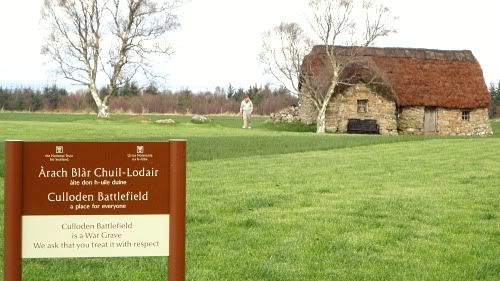
The short (and very incomplete) story of the time is that in 1688 King James VII of Scotland and II of England, a Catholic and a Stuart, had to flee to France because of the divisions between England, Scotland, and Ireland as they attempted to avoid civil war and function as 'Britain'. The parliaments of England and Scotland took on a more prominent role in governance, even though they invited the Protestant William of Orange and his wife Mary to come and rule in James' place. Also, the Scottish parliament made Presbyterianism the Scottish state religion, replacing Protestant Episcopalianism.
Flash-forward to 1745, with political infighting between the Whigs, the English and Scottish political party who argued against the Stuarts with their belief in an absolute monarchy and instead supported power sharing between the king and parliament, and the Jacobites, who supported the Stuart claim to the throne in the form of Prince Charles Edward Stuart (aka Bonnie Prince Charlie).
Add in support for the Jacobites from France, because things are never good between the English and the French, and you have a back and forth for the best part of a year with both sides taking and losing strongholds, until April of 1746, with the Jacobite army stretched thin and Prince Charlie wanting to make a decisive stand.
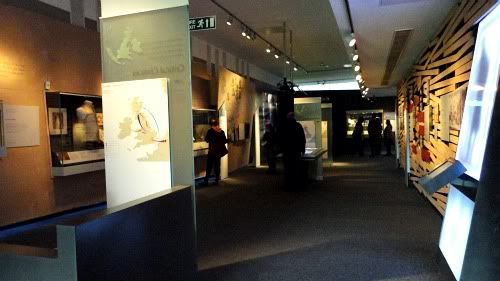
Inside the Culloden exhibit: throughout the halls, the right side tells the story of the Jacobites, the left, the story of the government.
From the National Trust for Scotland:
Rather than risk a pitched battle in their weakened state, the Jacobites agreed a final desperate plan: a surprise night attack. This night march to surprise the enemy in their camp could have been a brilliant strategy. Sleeping redcoats would have been no match for Jacobite troops. In reality, as the trailing Jacobite column stumbled along in the dark, it turned into a chaotic disaster. The Jacobites had failed in a critical gamble.
As dawn broke, battle was still not inevitable. Even now there was time for the army to draw back to Inverness and regain their strength at a safe distance. Bitter arguments broke out between the senior commanders - even the French envoy pleaded on his knees for the Prince to withdraw.
But the Prince was determined and took the decision to fight then and there. Many of his soldiers were asleep, exhausted from the night march, while others were away looking for food or had yet to arrive in the area.
Some Jacobite leaders favoured a retreat to high ground south of the River Nairn, others a withdrawal to Inverness. The Prince preferred to fight where they stood, on the moor at Culloden. With Cumberland's army in sight, Charles's luck was finally running out. The pipers began to play and the tired army struggled into position.
Towards one o'clock, the Jacobite artillery opened fire on government soldiers. The government responded with their own cannon, and the Battle of Culloden began.
Bombarded by cannon shot and mortar bombs, the Jacobite clans held back, waiting for the order to attack. At last they moved forwards, through hail, smoke, murderous gunfire and grapeshot. Around eighty paces from their enemy they started to fire their muskets and charged. Some fought ferociously. Others never reached their goal. The government troops had finally worked out bayonet tactics to challenge the dreaded Highland charge and broadsword. The Jacobites lost momentum, wavered, then fled.
Hardly an hour had passed between the first shots and the final flight of the Prince's army. Although a short battle by European standards, it was an exceptionally bloody one.
Following his victory at Culloden, the Duke of Cumberland was determined to eliminate the Jacobite threat once and for all. He wanted revenge: his army would crush the unruly Highlands, capture the Prince, and return to the main war in Flanders as soon as possible. There was to be no question of a further rebellion.
Within a few days of the battle, around 1,500 Jacobite soldiers gathered at Ruthven Barracks, ready to continue the campaign. To their surprise Charles gave the order to disperse and then went into hiding. For him, the Rising was over.
Unopposed, the government sent its army and navy across Scotland, punishing anyone suspected of Jacobite sympathies. The policy of 'pacification' of the Highlands had begun.
The government began to dismantle the structures of Highland society. Chiefs were deprived of their legal powers and clansmen of their weapons. Jacobite estates were seized by the Crown. The kilt and tartan were banned.
Culloden was the last battle of its kind fought on British soil, and it was bloody. Instead of capturing survivors to hold as political prisoners, Scottish Jacobites were slaughtered where they lay on the battlefield to send a message.
The visitor centre and exhibition were fantastically well done, and really educational for someone like me, who knew nothing going in. The set up of having the Jacobite story along one wall and the government story along the other all throughout the timeline was a great help and I think really allowed the centre to flesh out the story from both sides, instead of trying to combine it into one narrative.
They also were having a demonstration on weaponry before you went out onto the field. I learned that musket would be way too heavy for me (and I can only imagine the kickback from firing it), but I was pretty handy with a broadsword. And a shield and a hidden dagger.
The other great thing about Culloden is that the audio guide is included in your admission. Now, I'd never used an audio guide, so when they gave us the pack as you're walking outside, I almost said no. But there's something to be said for the story of a place being told in a local accent to make it feel even more real as you're walking through the battlefield.
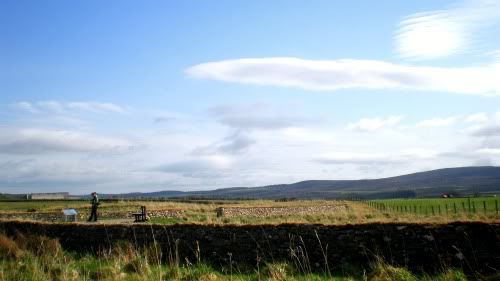

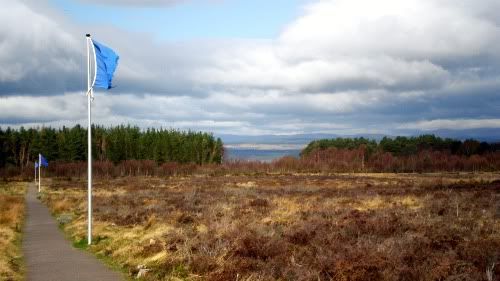
The moor is beautiful and vast, and we were lucky with a beautiful day to go walking through it. There were two lines of flags (red for the government, blue for the Jacobites) standing where the lines of each front were, and the trail goes down and between them to tell the story of the battle as you walk through the moor.
The only buildings are a house that's a replica of one that was standing there, and probably used as a military hospital for the government as it was behind their line, and the memorial cairn erected for the fallen Highlanders at Culloden.
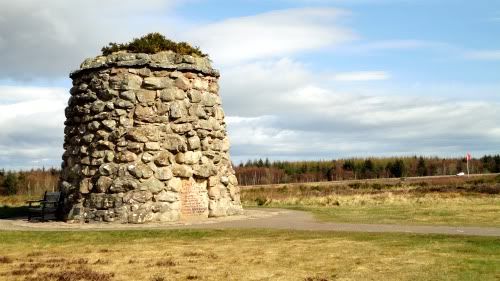
The inscription reads: The Battle of Culloden was fought on this moor 16th April 1746. The graves of the gallant Highlanders who fought for Scotland & Prince Charlie are marked by the names of their clans.

The Field of the English: While the Highlanders graves are marked by stones carved with the names of their clans, the burial place of the government dead isn't known, and is marked with only this stone at the edge of the field.
While I was going through Culloden, I kept trying to think of a proper American parallel to use when I made this post. The closest I can come is the feeling I had at Gettysburg as I walked through the battlefield there, but even that's not completely right. But then, why do I need an American parallel? It was it's own battle, it's own history, and one that I'm thankfully not so ignorant of any longer.

No comments:
Post a Comment